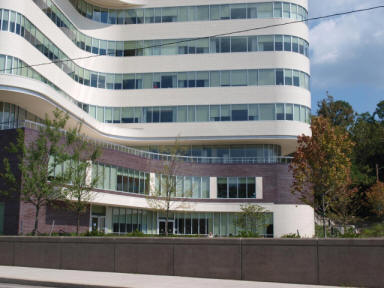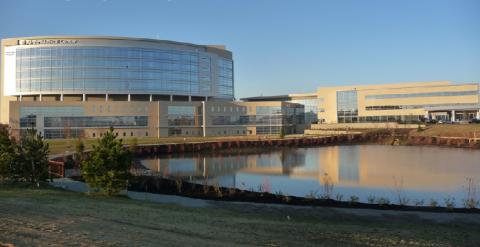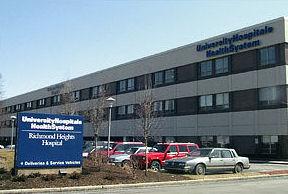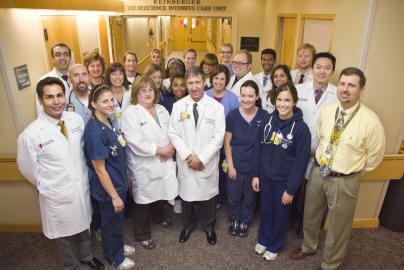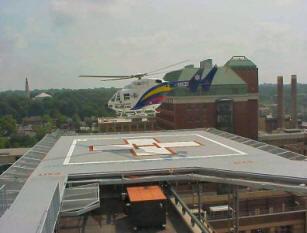Hospitals
In-patient neurology residency training is carried out at two sites: Cleveland Medical Center of University Hospitals and the Louis Stokes Veterans Affairs Medical Center. The different patient mix at the two hospitals provides residents with a thorough exposure to the broadest possible range of neurologic illness.
Cleveland Medical Center of University Hospitals
Cleveland Medical Center of University Hospitals is the primary teaching affiliate for the School of Medicine at Case Western Reserve University. It is a private, not-for-profit, 947-bed tertiary care and referral center. The Neurology service cares for inpatients in the Lerner Tower 4. There is a 14-bed intensive care unit, staffed by neurologists trained in intensive care and shared with the Department of Neurological Surgery. The Department has a full range of neurodiagnostic laboratories (including EEG, video-EEG monitoring unit, EMG, neurovascular ultrasound, autonomic function, neuro-ophthalmology, and sleep centers).
Cleveland Medical Center is the centerpiece of the University Hospitals. This includes 17 wholly or partially owned hospitals and 150 health care sites throughout Northeast Ohio. The system employs more than 15,000 physicians, nurses and support staff.
Louis Stokes Cleveland Veterans Affairs Medical Center
Within walking distance of Cleveland Medical Center, is the Louis Stokes Cleveland Veterans Affairs Medical Center (VAMC). The VAMC in Cleveland is devoted to providing the highest quality of care to veterans. In 2011, construction was completed on the Cares Tower, a 370,700 square foot and 8 floor facility that adds an additional 222 inpatient beds. The Tower also brings several additional services to the Cleveland VAMC, including a Blind Rehabilitation Center, Comprehensive Rehabilitation Center, Long-term Care Spinal Cord Injury, and an Expanded Polytrauma Center. Neurology Service at the VA is active in clinical care and academic research. It is closely affiliated with two VA Research Centers of Excellence, the FES (functional electrical stimulation) and APT (advanced platform technology) Centers.
The FES Center focuses on the application of electrical stimulation to enhance the functional capacities of individual with motor deficits due to stroke, multiple sclerosis and spinal cord injury. There is also a Gait laboratory at the VA, that performs research that is aimed at enhancing motor recovery after stroke by incorporating multiple techniques including FES, robotics, advanced treadmill training techniques and motor learning strategy to maximize recovery of upper and lower extremity motor functions and abilities to function independently. The APT center is developing new biomaterials and electronics to enhance the range of applications of biomedical engineering to neurological diseases. Another outstanding clinical and research resource is the Daroff/Dell’Osso Ocular Motility Laboratory, which includes world class researchers: Drs. John Stahl and Mark Walker. Drs. Robert B. Daroff and Lou Dell’Osso founded the initial eye movement laboratory in the VA almost 30 years ago. The ocular motility laboratory studies control of eye movements and how eye movements are disturbed in neurological diseases.
The Louis Stokes Cleveland VAMC provides care to more than 71,000 veterans each year in northern Ohio, through two inpatient facilities, twelve community-based outpatient clinics and three veteran centers. The Neurology service cares for acutely ill patients on its own wards in this 683 bed hospital, and provides outpatient care for veterans throughout Northern Ohio. Dr. Ronald Riechers is the Chief of the VAMC neurology service. He joins a distinguished faculty who provide care and also participate in active clinical and basic research programs. The medical center has been recognized for more programs of clinical excellence than any other VAMC: Open Heart Surgery, Care of the Seriously Mentally Ill, Geriatric Evaluation and Management, Substance Abuse Care, Spinal Cord Injury Care, Medical Care of the Homeless, and Domiciliary Care of the Homeless.
Ahuja Medical Center
Ahuja Medical Center is situated on a 53-acre campus near the intersection of I-271 and Harvard Road at Chagrin Highlands in Beachwood. The site offers convenient access from Cleveland’s eastern and southeastern communities, as well as Lake and Summit counties. Ahuja Medical Center is named in honor of UH Board Chairman Monte Ahuja, his wife Usha, and their family, recognizing their extraordinary philanthropic leadership. Phase one of the UH Ahuja Medical Center project is now complete and includes a 144-bed, seven-story hospital and 60,000-square-foot medical office building. Ahuja Medical Center provides a safe, supportive work environment with optimal ergonomic and operational efficiencies, including a “footstep-sensitive” design. The building’s shape, including its curved hallways, help decrease the distances nurses need to travel and patients need to be transported. The large number of independent and UH-employed primary care physicians and specialists practicing in the surrounding area practice at this innovative, state of the art medical facility.
Richmond Medical Center
Founded in 1961, University Hospitals Health System Richmond Medical Center is a full-service, 125-bed acute care facility serving the residents of eastern Cuyahoga County. The hospital has over 400 physicians representing over 30 specialties who provide expert care in a wide range of comprehensive medical and surgical services. Outpatient and inpatient consultations are available at Richmond.
Neurologic Critical Care Center
The Neuroscience Unit (NSU) is a 19-bed unit designed for the care of neurology and neurosurgical patients who require specialized intensive nursing and medical care. The NSU is involved with the care of complex patients with neurologic and neurosurgical disorders; acute treatment of stroke patients (i.e. Brain Attack), and evaluation of novel treatments for acute stroke. The unit is directed by Michael DeGeorgia, MD. Additional neurointensivist staff include Drs. Wei Xiong, and Ciro Ramos Estebanez, Alan Hoffer. The ICU is physically adjacent to Lerner Tower 4, the home of the neurology inpatient service. Expansion of the NSU was completed in 2017 with an increase in the number of beds and multimodality monitoring.
The Neurocritical Care Center offers fellowship training and is actively involved in a variety of research activities. More information is available on the Neurocritical Site of University Hospitals.
Joint Commission Certified Comprehensive Stroke Center
One of the major highlights of the Case residency program is the extensive exposure each resident receives participating in the evaluation and treatment of acute stroke. UHCMC is one of the few centers certified by the Joint Commission as a Certified Comprehensive Stroke Center. Our stroke and brain attack program has been active since 1993, and is one of the largest programs in the nation using intra-arterial thrombolysis.
Patients are evaluated with treatment initiated acutely by a team of the residents, Attending Neurologists, Neuroradiologists, and Neurointensivists.
Protocols for both intravenous or intra-arterial thrombolysis are used to treat acute stroke patients. Patients with acute stroke are triaged quickly from outlying hospitals and are often life flighted directly to University Hospitals - Cleveland Medical Center.
The patients initially cared for by a resident during a brain attack are continued to be followed by the same resident during their hospitalization from the Neurocritical Care Unit to the Neurology ward and later in the outpatient continuity clinic.
Reinberger Neuroscience Intensive Care Unit
The Reinberger Neuroscience Intensive Care Unit at University Hospitals provides complete critical care for all neurology, neurosurgery, and interventional neuroradiology patients and is covered 24/7 by dedicated neurointensivists, fellows, and residents. The 14-bed unit is state-of-the-art with continuous digital EEG and advanced multimodality monitoring capabilities and admits over 1600 patients annually.



